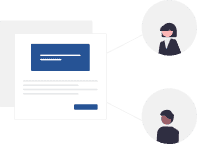How to generate an Equal Opportunities and Anti-harassment Policy
What is an Equal Opportunities and Anti-harassment Policy?
An Equal Opportunities and Anti-harassment Policy set out how a company deals with issues relating to discrimination, harassment, and victimization.
It is sensible for a company to provide mandatory training for staff during onboarding and as a refresher training every year to ensure they are fully aware of the company’s Equal Opportunities and Anti-harassment Policy and that they refrain from behavior that could be discriminatory.
Every employee should be provided with a copy of this policy. There is also an option to let employees sign and acknowledge their understanding of an agreement to this policy.
When an Equal Opportunities and Anti-harassment Policy should be used?
Equal Opportunities and Anti-harassment Policy should be included as part of your company policy and guideline documents for existing and new employees. The human resources (HR) department, the hiring manager, or the employees’ superior usually gives this to new employees.
Additionally, other best practice documents include the Employee Handbook, Anti-Bullying Policy, Grievance Procedure Guidelines, and Disciplinary Policy and Procedure.
Why is an Equal Opportunities and Anti-harassment Policy important?
An Equal Opportunities and Anti-harassment Policy are important to minimize and eliminate favoritism, eliminate workplace harassment by managers, supervisors, or co-workers with whom an employee has to come into contact regarding official work. Discrimination inside an organization is a serious issue that needs fast resolution. Favoritism is one of the results of discrimination inside an organization, it can also lead to appointing unqualified professionals in the job that can decrease productivity and overall performance of any organization.
On the other hand, implementing an anti-harassment policy in an organization is equally important. Harassment can take place in different forms and situations. Some examples of workplace harassment can be based on race, religion, sex, nationality, political belief, etc. so it is very important to eliminate these kinds of Favoritism and Harassment to make an organization a better place of work and thrive.
What is an Anti-harassment and Non-discrimination Policy?
The “Anti-harassment and Non-discrimination Policy” is a written document that outlines an organization’s commitment to maintaining a respectful and inclusive work environment free from harassment and discrimination.
What is the purpose of an Anti-harassment and Non-discrimination Policy?
The purpose of this policy is to establish clear guidelines and expectations regarding acceptable behavior and conduct within the organization. It aims to prevent and address issues related to harassment, discrimination, and any form of inappropriate behavior based on factors such as race, gender, age, religion, disability, sexual orientation, or other protected characteristics.
When should you use an Anti-harassment and Non-discrimination Policy?
This document is used by organizations of all sizes and across various industries to communicate their commitment to maintaining a safe and inclusive workplace. It should be shared with all employees, contractors, and stakeholders and should be regularly reviewed and updated as needed.
What are the components of an Anti-harassment and Non-discrimination Policy?
The components of an Anti-harassment and Non-discrimination Policy may include:
- Title: “Anti-harassment and Non-discrimination Policy” or similar.
- Policy Statement: A clear statement expressing the organization’s commitment to maintaining a respectful and inclusive workplace, free from harassment and discrimination.
- Definitions: Definitions of key terms such as harassment, discrimination, retaliation, and protected characteristics to provide clarity and understanding.
- Scope and Applicability: Explanation of the policy’s coverage, including its applicability to all employees, contractors, visitors, and stakeholders.
- Prohibited Conduct: Detailed list of behaviors that are considered harassment or discrimination, including examples and specific scenarios.
- Reporting Mechanisms: Instructions on how to report incidents of harassment or discrimination, including multiple reporting channels and assurance of confidentiality and non-retaliation.
- Investigation and Response Procedures: Outline of the steps the organization will take to investigate and address reported incidents, including timelines and possible disciplinary actions.
- Training and Awareness: Commitment to providing regular anti-harassment and non-discrimination training to employees and promoting awareness of the policy.
- Consequences: Explanation of the potential consequences for individuals found to have engaged in harassment or discrimination, which may include disciplinary actions, up to and including termination of employment.
- Review and Updates: Statement regarding the regular review and updating of the policy to ensure its effectiveness and compliance with applicable laws and regulations.
- Legal Compliance: Acknowledgment of the organization’s commitment to complying with relevant anti-harassment and non-discrimination laws and regulations.
- Effective Date: The date from which the policy is effective.
- Signatures: Signatures of senior management or authorized representatives to signify their endorsement and support of the policy.
Who can be members of an Anti-harassment and Non-discrimination Policy?
Members of the document include the organization’s leadership, human resources personnel, legal advisors, and any other relevant stakeholders involved in developing and implementing the policy. All employees, contractors, visitors, and stakeholders are bound by the policy and should be provided with a copy for reference and understandi
Conclusion
Although there is an Equal Opportunities and Anti-harassment Policy in an organization it is very important to conduct workshops or training to inform and educate the employees about the importance of these policies inside an organization, whom should they report to, and what are the reporting procedures. These kinds of practices help to maintain a healthy working environment in an organization and can also lead to better productivity, better employee satisfaction and retention, and overall growth of an organization.
You Might Also Like
Along with this document, make sure you see these other templates in our library:
Stay compliant with the Zegal template library
Zegal legal template are meticulously crafted with the precision of AI and the expertise of seasoned human lawyers, providing a unique blend of speed and reliability.
You can trust that Zegal agreements are legally sound and fully compliant with current regulations.
Whether you're a startup, SME, or a larger enterprise, Zegal contract management will automate and speed up your legal processes.
Using Zegal will reduce risk, save money, and improve efficiency. Let us take care of the paperwork so you can focus on running your business.
Don’t compromise on speed or compliance. Stay secure, compliant, and efficient with Zegal.






